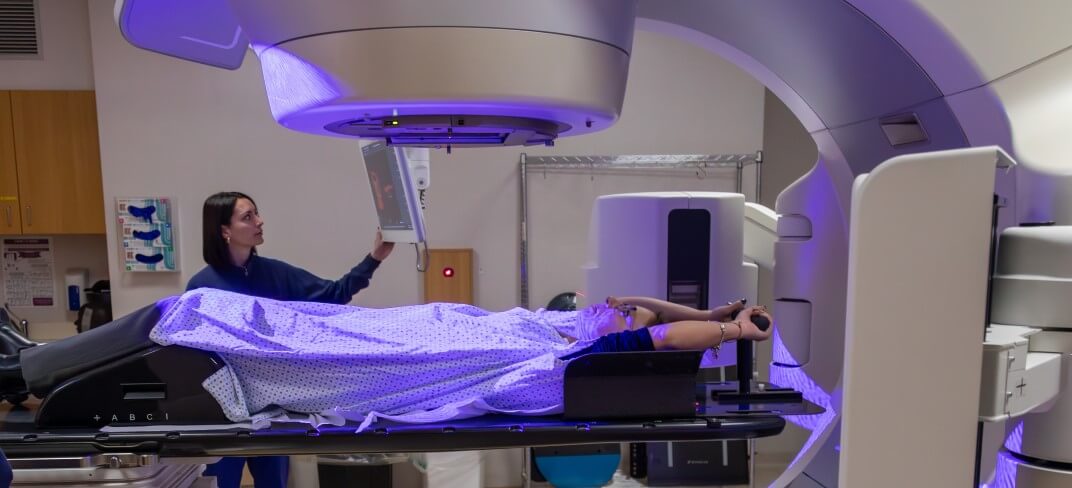The Difference Between Chemo and Radiation

When you or a loved one receives a cancer diagnosis, it’s normal to have many thoughts running through your head. You may wonder just how bad the cancer is or what it means for your future. You may also wonder what the treatment is actually like.
In terms of treatment, you may hear the words “chemotherapy” or “radiation.” Or maybe your doctor says you need a combination of both. Whatever your doctor recommends, you may wonder what the difference is between the two.
What Is Chemotherapy?
Chemotherapy, or chemo, is a category of drugs that doctors use to treat cancer. Chemo is a “systemic” treatment. This means it works through your whole body to kill existing cancer cells and prevent the spread of the disease. It is also used to reduce the size of the tumor and relieve pain, especially in cases where the tumor cannot be removed surgically.
Chemotherapy side effects
Chemo side effects vary depending on the type and amount of chemotherapy drug you need and how your body reacts to it. However, chemotherapy is a systemic treatment that “travels” through the body to target fast-growing cancer cells and can also target fast-growing, healthy cells, causing a variety of possible side effects.
Here are some of the fast-growing cells in your body and the side effects chemo may cause if it kills those cells too:
- Blood-forming cells in the bone marrow: Damage to these cells can cause anemia and increase your risk for infection and bruising.
- Hair follicles: Damage to these cells can cause temporary hair loss.
- Cells in the digestive tract: Damage to these cells can cause nausea, loss of appetite, constipation, and diarrhea.
Some chemo drugs can damage cells in the heart, kidneys, bladder, lungs, nervous system, and reproductive system.
Your doctor may prescribe drugs to protect healthy cells and alleviate the side effects of chemotherapy.
Types of chemotherapy
The exact drugs your doctor recommends will depend on the type and stage of cancer as well as your age and overall health.
There are many different ways you can receive chemo drugs. The most common are:
- Intravenous (IV) infusion: The medication goes directly into a vein, a process that often takes 30 minutes to a couple of hours.
- Orally: You take the medication by mouth.
- Injection: You receive an injection of the drug into your body (typically in your arm, thigh, belly, or hip).
- Topically: You apply a cream directly onto your skin.
Depending on your needs, you may receive the chemo at your doctor’s office, at an outpatient client, in a hospital, or even at home.
What Is Radiation Therapy?
Radiotherapy uses high-energy particles or waves to destroy or damage cancer cells. A machine, called a linear accelerator, sends high doses of radiation to the cancer cells or tumor. Unlike chemotherapy, therefore, radiotherapy focuses specifically on the part of the body where the tumor is located and attacks only the tumor cells, preserving the healthy ones as much as possible.
Radiotherapy may be indicated as a single therapy or together with chemotherapy to maximize the chances of success. It can also be used for palliative purposes, for example to reduce bone pain when the tumor has already spread.
Radiation side effects
Many people who receive radiation experience some degree of fatigue Many people may complain of tiredness and other side effects, depending on the part of the body treated.
For example, treatment of the pelvic area can cause sexual, fertility, urinary and bladder problems. Other side effects may include nausea, vomiting and diarrhea. Radiation therapy to the brain can cause headaches, blurred vision, and problems with memory and concentration. The doctor will be able to give all the information on the possible side effects of the treatment.
Types of radiation therapy
Radiation can be administered internally or externally.
External radiation therapy
The radiation beam is delivered externally by a machine, similar to a diagnostic radiological exam. A technician will protect certain parts of the body with special shields or blocks to prevent them from being affected by radiation.
The duration and frequency of treatment vary depending on the tumor, its location, general health and other factors. Each treatment lasts a few minutes.
Internal radiation therapy
In this case, the doctor places an implant in the body, in or near the tumor, which delivers large doses of radiation directly to the tumor's source.
The implant can take the shape of a thread, a ball or a seed and can be placed in a stable manner (permanent brachytherapy) or removed and replaced at regular intervals (temporary brachytherapy).
What Cancer Treatment Is Best for Me?
The oncologist and team of specialists work closely together to determine the best treatment plan for each patient. This may include, individually or in combination, chemotherapy, radiotherapy, surgery and immunotherapy.
Knowing and understanding all the available options is essential, so do not hesitate to ask your questions and share your doubts with specialists, who are the most reliable source of information and will be able to explain to you why one treatment is more suitable than another, how it will be administered and what any side effects will be.
Learn more about UPMC's oncology services.